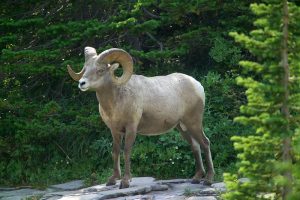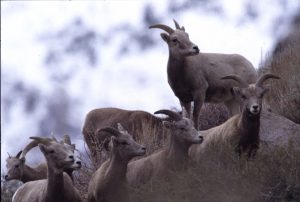
Sierra Nevada Bighorn Sheep. Original public domain image from Flickr
Sensory ecology is a growing field of scientific exploration that meaningfully engages sensory information–such as visual, olfactory, and auditory signals–with an individual’s natural environment. Research in this field provides us with key insights into the decision-making process of animals, which could potentially be used to better plan conservation projects and priorities.
A recent article by Berger et al. (2022), humorously titled “Seeing is Be-Leaving: Perception Informs Migratory Decisions in Sierra Nevada Bighorn Sheep (Ovis canadensis sierrae),” provides us with an example of such research and even offers guidance to future researchers who are interested in facilitating the migration of this species (hereby referred to as SNBS).
For some brief background on the study species, SNBS is actually a subspecies of Bighorn sheep that is solely found in the Sierra Nevada Mountains of California. Like many other species in today’s world, SNBS are currently marked as endangered and thus are the subject of multiple conservation projects. If you are interested in supporting or learning more about SNBS and current recovery projects, you might want to check out the Sierra Nevada Bighorn Sheep Foundation’s website.
The article above sought to understand the migratory habits of SNBS by studying the available sensory information in their environment and the influence that it has on the decision-making process. Behavioral plasticity, which is an individual’s ability to change their behavior, is currently understood as a response to the changes in risk-reward tradeoffs over an individual’s lifetime. Because of this, we would expect the migration of SNBS to be an example of a behavior that changes based on their physical and social environment. The authors based their research on four ecological hypotheses proposed by previous researchers, although they had the distinct goal to empirically determine which hypothesis had the most integrity.
Previously Made Hypotheses
Forage Maturation Hypothesis (Hebblewhite et al., 2008)
Animals choose to migrate by following the phenological changes of vegetation in their environments. Areas with increased plant growth offer a greater abundance of food, so traveling to these areas helps to maximize an individual’s nutrient intake.
Predator Avoidance Hypothesis (Skov et al., 2011)
Rather than moving towards a new habitat, individual’s travel away from their current one if they are at an increased risk of predation or hunting pressure. Additionally, this same hypothesis can be used to suggest that individuals travel away from their environments to avoid adverse climate conditions (such as drought, extreme temperatures, and weather events).
Terminal Investment Hypothesis (Clutton-Brock, 1984)
The argument here is that older individuals are more likely to take the risks of migration in the hopes of increasing the likelihood of successful reproduction. On the other hand, younger individuals typically take fewer risks associated with migration to prioritize their long-term survival and future reproductive potential.
Dominance or Competitive Release Hypothesis (Gauthreaux, 1982)
Less dominant individuals within a population are more likely to migrate so they can avoid intraspecific competition for resources in high density populations. Alternatively, weaker individuals may want to remain within a large population to increase their chances of survival. Large populations offer multiple benefits, such as increased predator vigilance (100 eyes are better than 2), reduced predation risk (you only need to be faster than the person next to you), and transmission of knowledge (wisdom of more experienced individuals).
Research Models

A herd of Sierra Nevada Bighorn Sheep. Access provided by Creative Commons
Berger et al. collected data from already conducted research and then used three different ecological models to interpret it. The Omniscient Model makes the incredibly unlikely assumption that individuals know exactly where they’re going and have an absolute understanding of their reasons for doing so. The Perception Model assumes that individuals make decisions based on their perceptual range. This model is certainly reasonable and is one they relied on most heavily as it takes into account local environmental factors and the information individuals can receive from them. The Memory Model differs from the first two in that individuals predominantly use knowledge of the past to make decisions, as opposed to the present or future.
Despite the omniscient model being almost certainly incorrect, all three of these models provide valuable information to their research. We have to remember that the goal of science is not to prove yourself right, but to do everything in your power to prove yourself wrong. By applying all three models and interpreting their data through them, they are able to fully test their hypothesis and find all routes of statistical significance.
What They Figured Out
After performing their calculations and applying all of their fancy methods, the authors determined that individual perception is the ultimate driver of the migratory decision-making process. To summarize their findings, their results show that:
Migration increases in a population if one or more dominant individuals go first. This has a sort of mob effect that increases with population size.
Groups are more likely to migrate if they are older, supporting the Terminal Investment Hypothesis listed above.
Short-distance migrations are decided by perceptual cognitive processes based on an individual’s present conditions.
Long-distance migration is driven by non-perceptual cognitive processes, meaning that individuals favor memory, instinct, or collective knowledge.
Why You (or someone else) Might Care
By now, most people understand that climate change is real, bad, and getting worse. Habitats are rapidly changing, and if they haven’t already changed, they almost definitely will in the near future. This means that we have a very limited amount of time to mitigate the effects of climate change by supporting communities that are transitioning from one habitat type to another.
The behavioral plasticity of a species could be a determining factor in their survival. The better we understand the decision-making process of individuals, particularly as they relate to migration and changing habitat conditions, the better we’ll be able to predict the effects of climate change in different environments and potentially inform our methods of conservation. For instance, long-distance migrators choose to migrate based on their memory of a target location. If this target location is no longer productive or has shifted in a way that can’t sustain the migrator, it is very likely that they won’t survive. Additionally, if we can better understand the social dynamics of SNBS populations, we can determine which individuals are most ‘trusted’ within a population and ‘use’ them to facilitate migration to a habitat that will best support them.
Overall, if we can figure out any way to better understand the SNBS decision-making process, the factors included in these decisions, and the prioritization of these factors, we can help to ensure their survival and prevent their extinction.
Subscribe Below For More Articles Like This!
